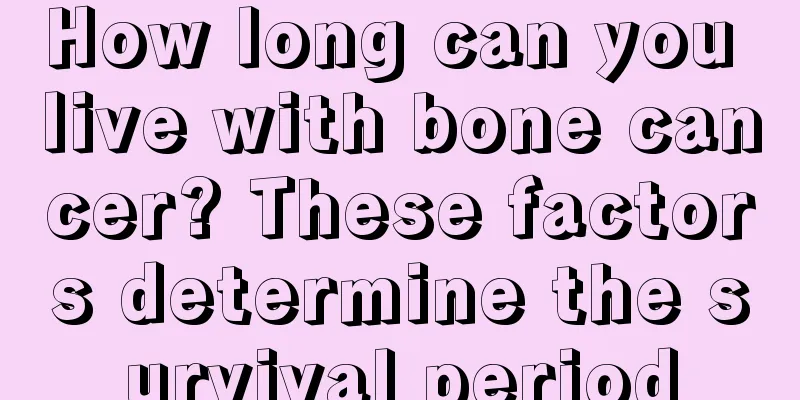Can goiter be cured? It manifests itself in this way

|
What we usually call goiter is actually a term for enlarged thyroid gland. When the disease occurs in the early stage, there will only be a lump, and there is no pain. If it is not treated in time, many discomforts will occur. This disease is curable, but severe cases require surgical treatment. 1. What is goiter? Goiter is commonly known as thick neck disease or big neck disease. Goiter can be divided into two types: diffuse enlargement and localized enlargement. Diffuse enlargement refers to uniform enlargement of the thyroid gland on both sides, which is usually not a tumor, while localized enlargement is often caused by a tumor on the thyroid gland. Therefore, when you find that your thyroid gland is enlarged, you should first determine its shape and characteristics. Patients with goiter should first determine the extent of their pain. Severe pain is usually caused by various thyroid inflammations, such as acute suppurative thyroiditis and subacute thyroiditis, both of which require timely treatment. Mild pain is not special because a variety of thyroid diseases may cause this symptom and it needs to be diagnosed through formal examination, so it is best to see a doctor in time. 2. Symptoms of Big Neck Disease In the early stages of goiter, only a hard, painless lump appears in the anterior neck. The lump has an uneven surface and grows rapidly, and does not move much up and down when swallowing. Subsequently, cervical lymph node metastasis occurs, and compression symptoms may appear, such as difficulty breathing, swallowing obstruction, and hoarseness. Early symptoms of thyroid enlargement: a lump in one lobe of the thyroid gland, which grows slowly, is usually solitary, has a complete capsule, is clearly demarcated from the surrounding normal tissue, is painless and tender, has a medium-hard texture, a smooth surface, is not adhered to the surrounding area, and can move up and down with swallowing. The neck becomes thicker and the texture is generally soft. When the swelling is obvious, the mass in the front of the neck may protrude forward and fall or compress backward, causing shortness of breath or even dyspnea, or also cause a feeling of choking when swallowing; in the case of nodular type, the size and hardness of the nodules may be uneven, and some nodules are harder; there are generally no systemic symptoms, and there is a history of local epidemics. 3. Is goiter easy to treat? The treatment of goiter can be symptomatic, and surgery is required for those with obvious symptoms. For those with obvious goiter, levothyroxine can be tried. For those with obvious goiter and compression symptoms, surgical treatment should be actively adopted. The causes of sporadic goiter are complex and difficult to treat, especially for elderly patients. Levothyroxine can be given, but the effect is often not obvious. During the treatment, the level of thyroid-stimulating hormone must be strictly checked and the medication must be adjusted according to the level of thyroid-stimulating hormone. |
<<: Self-treatment gymnastics for cervical spondylosis can actually be done like this
>>: What are the causes of spots on the face? There are three reasons
Recommend
How is the mid-term treatment effect of nasopharyngeal carcinoma
The treatment effect of nasopharyngeal carcinoma ...
Will early kidney cancer recur?
Early-stage kidney cancer does have the possibili...
What are the early symptoms of lung cancer? 7 early symptoms of lung cancer
The early symptoms of lung cancer should be known...
Why is my body thin but my face fat?
It may be due to baby fat. Some people are not un...
Does small cell lung cancer have a high cure rate in the early stage? Revealing the life expectancy of small cell lung cancer
In recent years, lung cancer has become one of th...
What to do if you can't eat and feel nauseous due to pancreatic cancer
Loss of appetite refers to a sudden decrease in f...
Can I still have sex if I have a urinary tract infection?
Urinary tract infection is a disease that many pe...
What is the reason for yellow urine? 7 symptoms will help you understand the reason
Urination can not only help the body excrete some...
What is the gallbladder used for
The gallbladder is an organ in our body that is n...
Can ginger be used to rub scars to remove them?
Ginger has a certain effect in removing scars and...
What causes vasculitis?
Many people know about vasculitis, which is a vas...
Is degreaser toxic?
We know too little about degreasers, because we c...
Symptoms of breast cancer in women
Among breast diseases, breast cancer is the most ...
Dragon fruit has a laxative effect
The most common problem in life nowadays is dry s...
What are the symptoms of early lung cancer? Beware of several early symptoms of lung cancer
Everyone is very familiar with lung cancer. It is...









